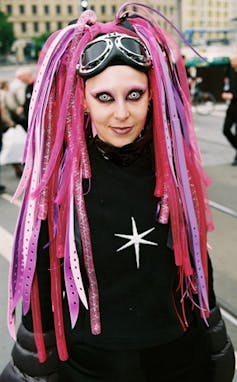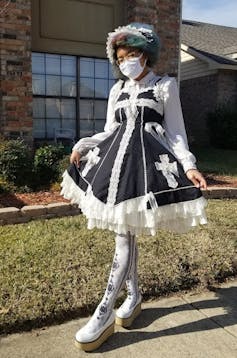Goth is the subculture that never died – or more precisely, perhaps, remains undead. The persistence of the subculture’s style is due to the remarkable richness of the cultural tradition on which it draws, and its malleability – its striking ability to absorb new influences into a recognisably coherent aesthetic.
Goth’s visual style has left as vivid a legacy as its music, one that continues to inspire designers, creatives and today’s teenagers far beyond its initial invention.
Early goth fashion shared many of the same reference points as punk. Many of its early icons, such as The Damned’s singer Dave Vanian and Siouxsie Sioux of Siouxsie and the Banshees, straddled both scenes.
In late 1970s and early 1980s Britain, subcultural style was very much a DIY affair. In the economic recession of the late 1970s, an improvised approach to style became a necessity for many young people. As the economy boomed later in the 1980s, this remained a form of resistance to a mainstream culture that fetishised wealth. In the ongoing spirit of punk, those pursuing “alternative” style would raid jumble sales and charity shops, recycle army surplus, customise high street fashion and make their own clothes and accessories.
This creative approach to style has been the key to the subculture’s longevity. Goth has always been about mixing things up and adapting what you find to fit your own aesthetic.
The goth aesthetic distinguished itself from punk through its preoccupation with imagery of death and decadence. As such, it seemed to articulate the underlying mood of Margaret Thatcher’s Britain – a culture in which pervasive images of wealth and success were underpinned by policies facilitating the disintegration of the social fabric. The earliest goth ensembles, like those associated with London’s Batcave club, were characterised by ripped fishnet stockings, repurposed bondage gear, deathly makeup and improvised chain jewellery. Towering, backcombed, dyed black hairstyles were a crucial element of the look.
As the 1980s wore on, however, goth style diversified, absorbing looks from other subcultures such as metal, rockabilly and even hippy psychedelia in the model of Kate Bush or Stevie Nicks.
Diversification of goth style

Although the goth music scene began to lose impetus in the early 1990s, versions of goth style began to appear on the catwalks.
This was most prominent in the work of British designer Alexander McQueen. His uncompromising collections experimented with the macabre in ways that thrilled the alternative scene and high fashion insiders alike.
Meanwhile, goth style became more available to mainstream consumers through high street versions of designer trends. In the US, the Hot Topic chain, founded in 1989, sold alternative style to teenagers through regional mall outlets.
For some, this commercialisation diluted goth’s countercultural charge. In contrast to the DIY culture of the 1970s and 80s, a desirable Goth look became became increasingly expensive to acquire.
Nevertheless, the subculture proved resilient, expanding to incorporate new influences. By the later 1990s, hybridisation with dance music culture produced cybergoth. Ensembles combining colossal platform boots, neon hair extensions and tech accessories like masks and goggles evoked a dystopian, posthuman future.
Read more: The gothic vision at the heart of Alexander McQueen's savage beauty

The international spread of the subculture generated new styles, too. Japanese Gothic Lolita style aimed to refashion its wearer in the image of a Victorian doll.
Exported internationally in the early 2000s via manga and anime, Gothic Lolita became a major influence on western goth style. It indirectly inspired “cute” gothic looks like “pastel goth” – goth style in the sweet, childish colours the subculture once rejected.
At the same time, many goths cultivated a passion for authentic recreations of historic costume, harking back to period styles inspired by the literary and cinematic tradition of the gothic. At the twice-annual Whitby Goth Weekend, founded in 1994, many participants pay tribute to Dracula author Bram Stoker by parading the sea front of the town where the author found his inspiration for the novel in meticulously crafted Victorian ensembles.
For members of the subculture, one particular style might define their personal image, or they might choose to wear different looks for different occasions.
The “corp goth” even adapts their look for the corporate environment, wearing office-friendly versions of the style. But crucially, by 2023, there are many ways of being a goth.
The secrets of goth’s endurance
Goth style has its controversies. Subcultures are, understandably, resistant to the appropriation of their style by outsiders. There is endless debate about whether offshoots and associated aesthetics such as emo or steampunk can be counted as goth or not.
While the finer points of these debates can be difficult to resolve, this very diversity is the key to goth’s longevity. Goth is not one look, one style – it is a rich, complex aesthetic drawing on many influences across literature, art and culture. This makes it remarkably resilient to cultural change, as it is able to shift to meet new demands.
Goth is not static, but a living tradition. Research shows that many goths remain active in the subculture long past youth. Moreover, new generations of goths continue to seize the subculture and make it their own.
One of the most dynamic developments of recent years is the mobilisation of goths of colour, sometimes known as Afrogoths, who resist the presumed association between goth and pale skin and draw music and fashion inspiration from black culture.
It is important that we recognise these new ways of being a goth, even if some of them find connection through visual rather than musical culture. In them, lies the subculture’s lively (undead) future.

Looking for something good? Cut through the noise with a carefully curated selection of the latest releases, live events and exhibitions, straight to your inbox every fortnight, on Fridays. Sign up here.
Catherine Spooner does not work for, consult, own shares in or receive funding from any company or organisation that would benefit from this article, and has disclosed no relevant affiliations beyond their academic appointment.
This article was originally published on The Conversation. Read the original article.







